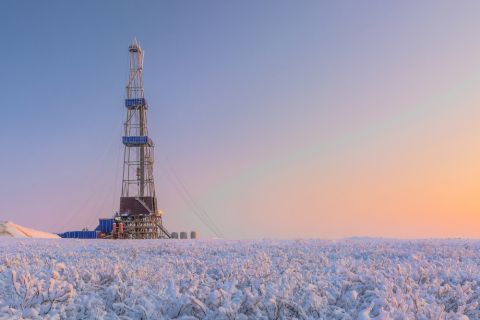For artificial lift in steam-assisted gravity drainage (SAGD) projects in Canada’s oil sands, high temperatures can create problems for elastomers in progressive cavity pumps (PCPs). At the same time pockets of steam can cause the pump to run “dry” with no fluids, causing problems with traditional PCPs.
Over the past four years Cameron has been developing a metal-to-metal PCP solution where pumping efficiency can be improved in these wells.
In this design the stator uses a steel core inside a steel tube, which forms the internal double helix. The rotor is manufactured with a slight clearance while the pump relies on the viscosity of the produced fluid to create the cavity seals, according to Tariq Ahmed, product manager for artificial lift, Cameron.
Cameron is getting close to field trials with its CAMM2 metal-to-metal seal technology for PCPs. “We’re trying to do a couple of trials in Canada and some in Venezuela this year,” he continued. “We’re really interested to see what we’ll find when we put this pump in the field.”

Unique stator design
In standard pump technology usually there is an elastomeric where rubber-to-metal contact creates the seal. The compression of rubber by the metallic rotor is what creates the seal and the pressure capability in the cavity in the pump, he said.
“With metal-to-metal seals you don’t have that compression seal, so we were really dependent on the resistance to flow created by tight tolerances between the rotor and stator. That had been the traditional way to handle metal-to-metal PCPs,” Ahmed explained.
What Cameron accomplished was to develop a stepped stator profile that creates additional turbulence. “What happens is that when the fluid is trying to travel from a higher-pressure cavity to a lower-pressure cavity, there is high resistance in that small clearance interface. Almost by accident we found that not having a smooth rotor interface allows us to handle gas [steam] significantly better,” he continued.
With traditional smooth metal surfaces the stator and rotor tend to bind up and have a galling effect with metal-to-metal surfaces on a dry run. In this type of application, a pocket of steam production coming into the pump is a failure mechanism.
“Because ours is a stepped profile, it almost creates a bearing interface. On test benches, we ran the metal-to-metal PCP dry for a significant amount of time. The pump ran nine hours dry and was then put back into operation with no loss in efficiency,” Ahmed said.
One other benefit of the stepped profile is the ability of the pump to move solids without damage to the rotor or stator. In the conventional smooth interfaces, the rotor captures solids particles and tries to impregnate those into the metal.
“When we have a step profile, it gives the solid particles a place to rest while the rotor travels by those. The solids then potentially can be picked up by the fluids in the following cavity rotation,” Ahmed said.
One model of metal-to-metal PCP has been developed at the moment. The pump can be installed from 457 m to 1,372 m (1,500 ft to 4,500 ft) deep. It has a flow-rate range of up to 1,500 bbl/d. “We do plan to create pump geometries up to 5,500 bbl/d in the future,” he explained.
“Most of the thermal applications are pretty shallow, especially in Canada. We’ll be going to maybe 1,524 m [5,000 ft] at the deepest initially. We will develop a slightly deeper application for the Venezuelan market,” he continued.
Given the steam-generated temperatures in these wells, expansion and contraction could be problems. “Being an all-metal system that uses the same material for the rotor and stator, we do expect some expansion. However, we included an expansion profile into the design. So far in the customer profile on which we’re working, we don’t see any seal issues from that point,” he continued.
Constant thickness elastomer
For a higher gas-oil ratio (GOR) Cameron has launched a constant-thickness (CT) PCP, called CAM-CT PCP, which differs from conventional PCPs that have varying thicknesses of rubber inside the pump geometry when dealing with higher GOR, higher temperatures and lighter crudes (35º-plus API gravity).
“With these applications, there is a significant amount of swelling, which deforms the shape of the pump,” Ahmed explained. “The CT geometry allows us to maintain the shape as we go to higher API gravity, temperatures and gas rates. It has been used in deeper applications than conventional PCPs to depths of 2,287 m [7,500 ft]. We are planning to use it with crude as high as 42ºAPI gravity.”
The wider applications are a result of an elastomer that is hydrogenated. It was developed using the company’s BOP elastomeric technology in its elastomeric technology center. “We used the knowledge and experience we gained in developing BOP rubber to develop artificial lift PCP rubber that would handle higher API gravity crude and be resistant to explosive decompression,” he continued.
“We’ve installed more than a dozen of these pumps in the last year. These pumps are outperforming expectations. To give you an example, in Venezuela we started a pilot project with three pumps. All of them have more than doubled the runlife of the
previous pumps in those applications,” Ahmed said.
The crude oil in Venezuela is mainly heavy oil with a high GOR. “As Venezuelan reservoir pressures are depleting, the GORs are increasing. That is causing a lot of conventional PCP technology to fail prematurely within six to nine months. Operators that are having difficulties with conventional PCPs are looking to adapt the CT technology,” he added.
In replacing small electric submersible pumps (ESPs) in low or medium flow rates in these high-GOR applications, PCPs can handle up to 50% gas in the cavity for a reasonable amount of time. “We did have some good histories in the Permian Basin and Rockies with these types of applications,” Ahmed said. “ESPs faced gas interference issues, causing failure, whereas the PCPs had better runlife in those applications.”
CT stators have several advantages over traditional PCPs, according to Cameron, which include even elastomer swell across the entire cross section, higher pressure per stage due to the metal backbone behind the elastomer, improved heat dissipation, improved bond interface from the stepped interior profile and higher operating temperatures around 121 C (250 F).
Recommended Reading
Wayangankar: Golden Era for US Natural Gas Storage – Version 2.0
2024-04-19 - While the current resurgence in gas storage is reminiscent of the 2000s —an era that saw ~400 Bcf of storage capacity additions — the market drivers providing the tailwinds today are drastically different from that cycle.
Biden Administration Criticized for Limits to Arctic Oil, Gas Drilling
2024-04-19 - The Bureau of Land Management is limiting new oil and gas leasing in the Arctic and also shut down a road proposal for industrial mining purposes.
PHX Minerals’ Borrowing Base Reaffirmed
2024-04-19 - PHX Minerals said the company’s credit facility was extended through Sept. 1, 2028.
SLB’s ChampionX Acquisition Key to Production Recovery Market
2024-04-19 - During a quarterly earnings call, SLB CEO Olivier Le Peuch highlighted the production recovery market as a key part of the company’s growth strategy.
Exclusive: The Politics, Realities and Benefits of Natural Gas
2024-04-19 - Replacing just 5% of coal-fired power plants with U.S. LNG — even at average methane and greenhouse-gas emissions intensity — could reduce energy sector emissions by 30% globally, says Chris Treanor, PAGE Coalition executive director.





